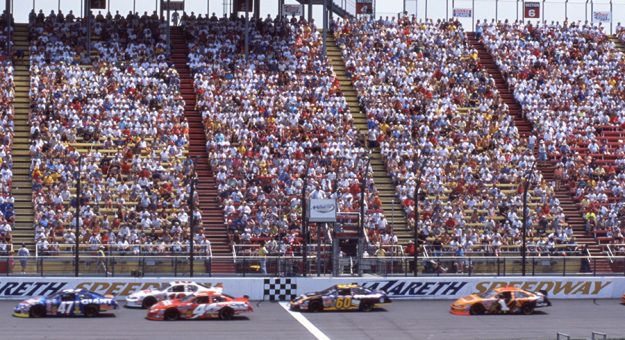The mile was dead for a decade when Reading Fairgrounds promoter Lindy Vicari, a longtime Fried rival who’d lost his own track to a shopping mall, grabbed a couple of partners and announced plans to resurrect Nazareth National. Atop his famed grader, Vicari recontoured the speedway into an even mile, built new stands and announced a blockbuster 1982 opener scheduled against Super DIRT Week at Syracuse.
Construction delays at Nazareth tabled the standoff and pushed the opener to the first weekend of December 1982, when Reading hero Kenny Brightbill copped the modified money on a 70-degree day. The rivalry resumed for 1983 when Vicari ran against Syracuse, offering $50,000 to his modified winner, who again proved to be Brightbill. Besides the payoff, the race was most notable for drawing a handful of DIRT defectors from Syracuse.
Vicari ultimately fell victim to the same financial realities that doomed Fried’s vision. Despite a multi-event calendar with shows for sprint cars, USAC and small-block modifieds, lenders foreclosed on the site after Carl Collis claimed Vicari’s final modified show in early 1984.
Following bankruptcy proceedings, the site became dormant until a new ownership team led by Roger Penske, along with Andretti and Danny Sullivan, bought the place in 1986. Penske, whose IndyCar teams were based in Reading, Pa., promptly paved the track, made everything spotless and renamed the facility Pennsylvania Int’l Raceway.
By this time, Interstate 78 had been extended across the Lehigh Valley, meaning New York City access was even better.
Penske and his famous partners made clear improvements to the site, led by a towering new grandstand. PIR presented an impressive variety of events, including one of the seven shows set by the short-lived Stock Car Connection, though the event was rained out after qualifying.
Things went better for the CART debut in 1987, a hometown romp by Michael Andretti. Through the years, the facility hosted the NASCAR Camping World Truck Series, NASCAR Xfinity Series, NASCAR Whelen Modified Tour, IROC and the Super DIRTcar Series modifieds.
CART was the most prominent presence at PIR during Penske’s period at the helm, running continuously from 1987 through 1999. Emerson Fittipaldi won there three times and Michael Andretti twice. Patrick Carpentier led Formula Atlantic/Indy Lights winners from 1991 through 2001 with a pair of victories.
The Lehigh Valley continued to grow, with hotels and restaurants reasonably near the track. And in 1996, the first shots were fired in the destructive war of attrition between CART and the Indy Racing League that divided the pinnacle of American motorsports.
Penske soon renamed the place again, this time to Nazareth Speedway. He later sold all of his speedway holdings to NASCAR, through its International Speedway Corp. subsidiary. NASCAR worked in its own improvements and continued the schedule at Nazareth.
NASCAR already had established dates for its national touring series at other facilities in the Northeast, including Pennsylvania’s Pocono Raceway, Watkins Glen (N.Y.) Int’l and New Hampshire Motor Speedway. As the newest NASCAR track, Nazareth faced a limited selection of dates that weren’t already taken by the other locales.
That often meant running early or late in the season, iffy weather propositions in eastern Pennsylvania. The crowd count continued to skid. The IRL date in 2000 was postponed due to snow. A combined IRL/USAC weekend in April 2002 saw sleet waft from the sky while the Indy car field was under the green. Todd Szegedy won the final race at the track, a 2004 Whelen Modified Tour event.
A development firm has owned the property since 2015, but no repurposing plans have been solidified.
It’s intriguing to contemplate what might have been. Fried built a huge track with lights. Penske paved it. In financial health, Nazareth National might have been an ideal venue for today’s made-for-TV racing: A smallish superspeedway, easily covered by TV cameras, capable of holding live events even in prime time. If the crowds hadn’t withered and the weather cooperated, it could have happened.
“Fried was hoping, I think, that Nazareth National would have become the dirt-surface successor to the National Open at Langhorne,” said Auto Racing Research Associates co-founder Bill Braga, a longtime Nazareth mile attendee. “And like the people who came later, he wasn’t shy about trying different types of promotion. But ultimately, he didn’t have great attendance at the big track, either. Maybe it just never really found its way. In the end, there were just so many racing dollars to go around.”
